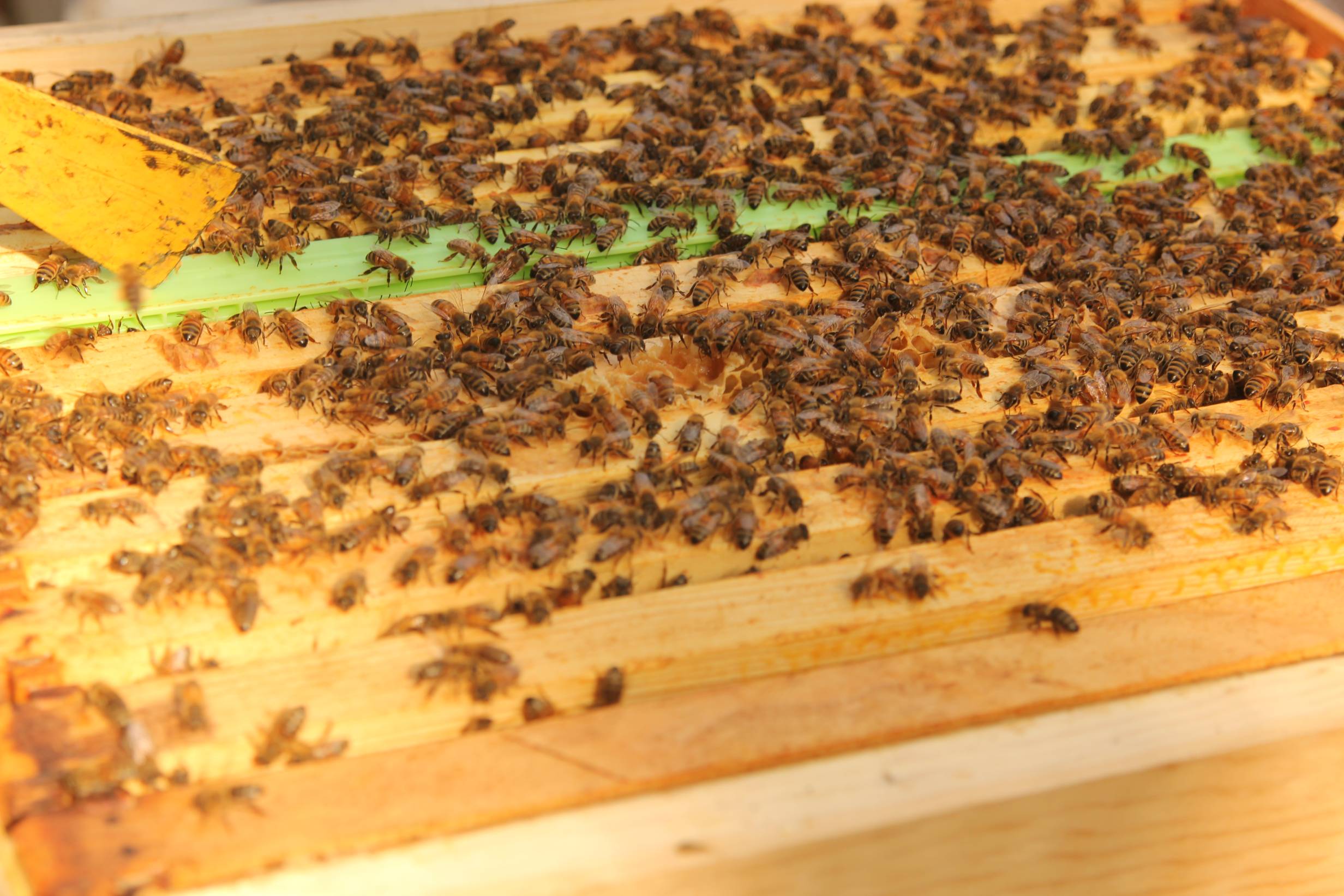There are those who claim farming is in their blood, and for some, farming is just their natural instinct. Maggie Wachter has only been beekeeping for about five years now, but she’s already got fifty hives buzzing between Champaign County and Chicago Heights, IL. Coming from a family of both rural and urban farmers and gardeners, it’s no surprise her hives have grown so far over the past few years. She runs Second Nature Honey, and sells the raw product out of select natural food outlets such as Strawberry Fields, Common Ground Food Co-op, and straight from the stand at the Bloomington Community Farmers’ Market.
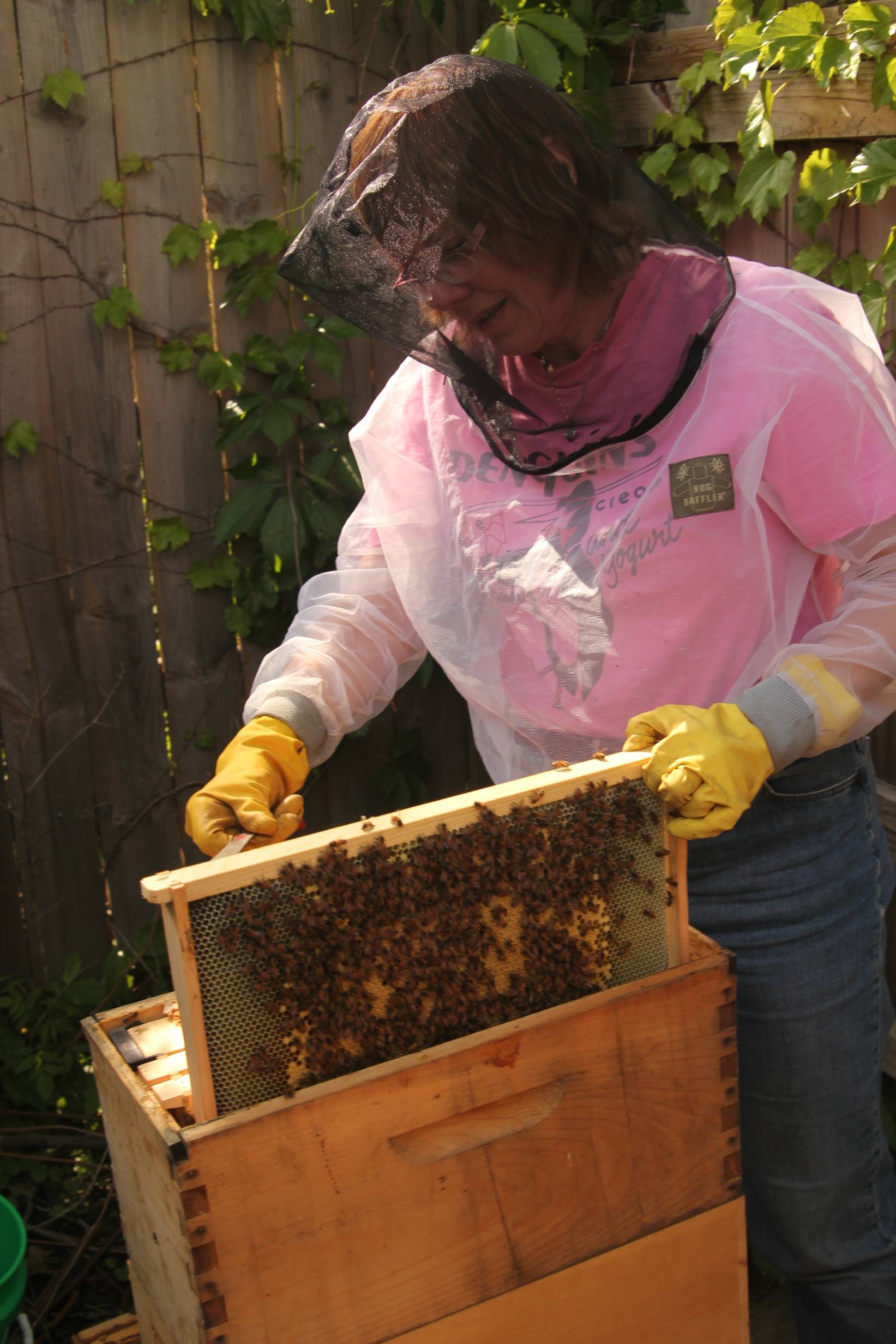 Wachter doesn’t just keep her passion of beekeeping to herself; she offers introductory- and advanced-level beekeeping courses at Parkland, and has a small teaching apiary in central Urbana. Her Dutch barn-style house, filled with all sorts of beekeeping equipment and half-built beehive boxes and frames, is home to a small number of interns who help her out with projects both large and small.
Wachter doesn’t just keep her passion of beekeeping to herself; she offers introductory- and advanced-level beekeeping courses at Parkland, and has a small teaching apiary in central Urbana. Her Dutch barn-style house, filled with all sorts of beekeeping equipment and half-built beehive boxes and frames, is home to a small number of interns who help her out with projects both large and small.
Wachter’s first job was in education. After receiving her Master’s in Library and Information Science from the University of Denver, she worked as a school librarian in small prairie-town schools in Colorado. Following a desire to speak French, she moved to Europe and worked for the United Nations for 25 years out of Belgium, France, and Switzerland as a government documents librarian. Around the resignation of 7th Secretary General Kofi Annan, Wachter decided to retire and began thinking about what else she’d like to do beyond working with the U.N. After a friend encouraged her to move to Urbana, Wachter first entered a Master’s program in Recreation, Sport and Tourism at the University of Illinois, but soon reconsidered: “I wanted something that was more one-on-one with vulnerable populations, so I switched to social work. But at the same time, someone gave me a beehive, and boy that changed everything!”
Her first hive was fortunately very understanding and self-sufficient, and by her second year she began to “split” and expand. Yet, anyone can’t simply plop down a beehive just anywhere and expect it to thrive. Wachter’s current network has been carefully established along flower-rich locations, such as a Daylily farm in Philo, IL and a Community Share Association garden in Chicago Heights:
It takes time to find the right location to put hives on. You need farms. To do it right, you need organic farms. Not a lot of corn around, but a variety and diversity of plants. So little by little, I started to find farmers who wanted bees on their lands. Now I have about five farms that are hosting my bees.
Wachter couldn’t have made it this far without the aid of some very experienced 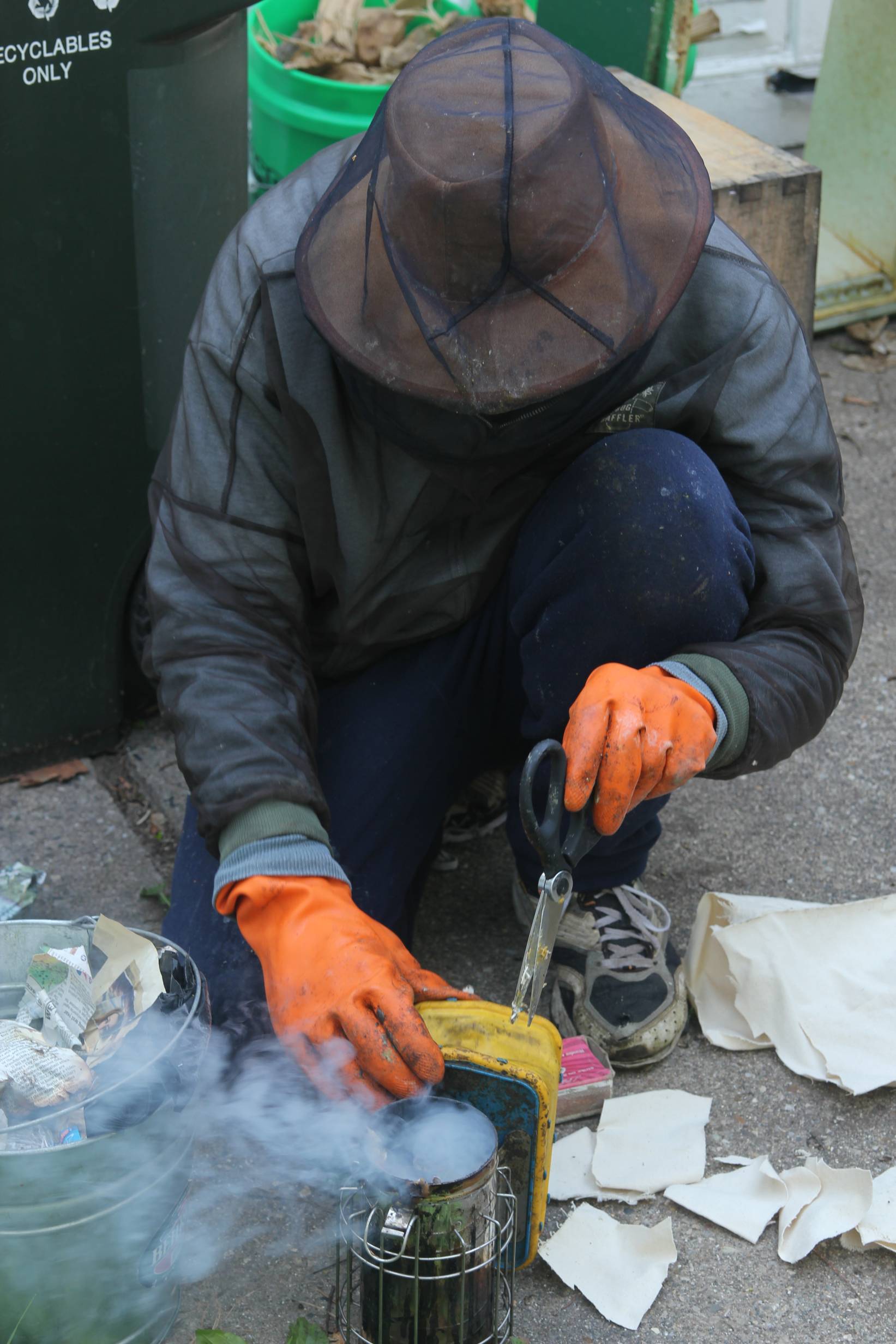 beekeepers and, of course, her own bees themselves. They teach her all sorts of lessons in beekeeping, sometimes serendipitously. She discovered a safe and effective method of providing hydration in the hot summer months after unintentionally leaving a few small, plastic pails filled with water and fallen leaves outside of her garage, which allowed her bees to drink without risk of drowning.
beekeepers and, of course, her own bees themselves. They teach her all sorts of lessons in beekeeping, sometimes serendipitously. She discovered a safe and effective method of providing hydration in the hot summer months after unintentionally leaving a few small, plastic pails filled with water and fallen leaves outside of her garage, which allowed her bees to drink without risk of drowning.
Wachter has observed her bees accomplish great feats of teamwork to take care of their own hives. Their brood nursery, located in the lower boxes of her hives, must be kept at a temperature of about 95 degrees Fahrenheit. When a hot and sunny day gets over 100 degrees, her bees will organize themselves: “There’s a group at the bottom of the [hive] entrance that are beating their wings to create a current of air, and there are others at the top and they’re actually circulating air through the hive to keep it cool.” During the harsh Midwestern winters, bees will, instead, cluster up into tight groups to survive up to 50 degree wind chill: “The colder they get, the tighter they get.” This lasts until the spring, when the temperatures warm up to 45 degrees. Only then will they start to relax and eventually disband their cluster.
Most importantly, bees need a sufficient reserve of honey to keep warm. About two boxes full of honeycomb frames, containing about 100 pounds of raw honey each, will feed a strong hive through the winter. However, a drought last summer reduced the hives’ overall honey yield, and some of them went into the winter with no honey at all. “They’re living on sugar, but they’re still alive,” Wachter said with a 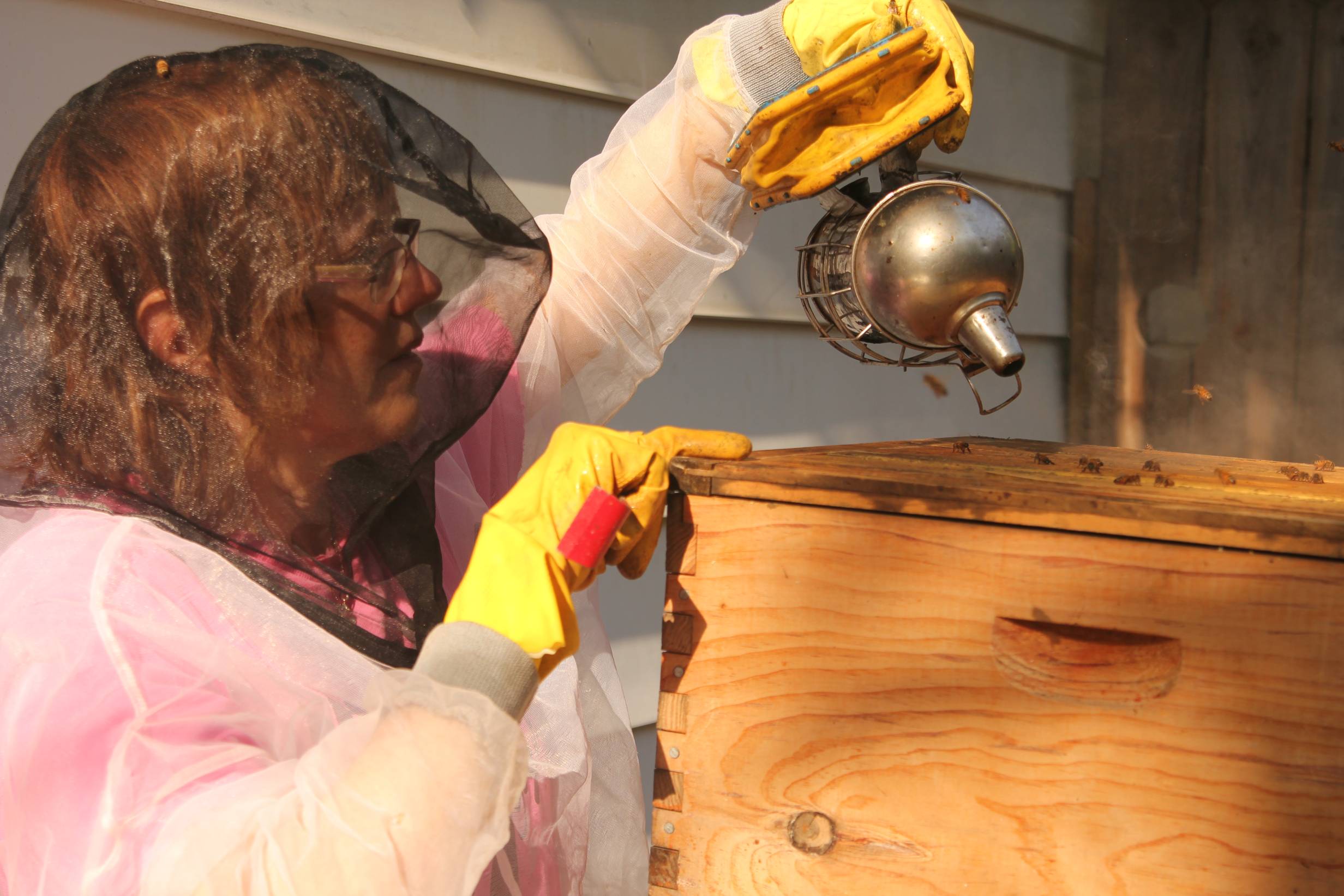 modest chuckle.
modest chuckle.
She’s quite mindful and protective of her bees, despite the wildlife, threatening diseases, and harsh weather known to the Midwest. She rejoices in the constant feedback she receives while feeding and working with her hives. Once, while she was pouring syrup into an open mason jar inside one of her weak hives, her bees were hovering from side-to-side around a clear stream of syrup, licking it as it dropped into the jar. “They’re the teachers; they teach you things like what’s really important: finding the flowers, having the friends to help you when you’re in trouble,” she said. “They have some really good values.”
Wachter constantly talks to her bees while working with them, and believes that they can recognize her voice. “They seem pretty at ease when I talk to them,” she said, admitting that talking to them also makes her feel the same. She begins her work by announcing her presence and reminding them they’re all in this together; they all want this hive to succeed. When she thinks like that, she feels like she’s part of the hive too:
I call it the bee space. When you go into the bee space, you don’t know when you’re coming out. You’re in there, with the bees. I used to make appointments for after beekeeping. I don’t do that anymore. Once you’re in there, time stands still. And it’s you and the bees and the natural world. There’s something about beekeeping that gives you a door into nature that’s so direct and profound you forget that you are human. Or you forget they’re not human!
Technically, “bee space” is actually a beekeeping term to describe the largest space in the hive between the honeycomb frame and the box wall that bees do not fill up with wax combs. The term originates from L. L. Langstroth, a Philadelphia native from the nineteenth century who first patented beehive boxes with removable honeycomb frames. According to Wachter, bees don’t like space and they’ll try to stuff all sorts of things into it. For example, if a wild mouse burrows into a beehive, defensive bees will attack it by using propolis (a sticky substance that honeybees collect from various botanical sources) to glue it in place. They won’t eat the mouse because bees are vegetarian. However, its decomposing carcass could spread diseases to the hive’s brood or larva, and would need to be removed like other foreign threats, including ants and mites. This is the great advantage of bee space: the ability to directly care for honeybees in close, unrestrained contact. “It just keeps the hive organized so humans can work with it and presumably help the bees,” Wachter explained.
One of the most fascinating things about working with bees is learning to understand the decisions of the hive mind:
It’s not the queen that makes the decisions; it’s the whole hive and we don’t know how the decisions are made.
Mindfulness is very important. You’re in the present. You’re not thinking about the past or planning the future. You are in the moment. The bees are very good at keeping you mindful. If you get distracted, the bees will bring you back to the situation. If you start feeling fear, the bees feel it. They feel it from you and they reflect it back to you. They get edgy and nervous. So it’s important to keep yourself calm, present, grounded in the moment.
During the spring and summer, hive populations need to be carefully monitored, or else a crowded hive might suddenly swarm off and relocate. “If they get too big too fast, they’ll swarm. They’ll get up and leave,” Wachter said.
Currently, Wachter is working towards her Master of Social Work so that she can teach beekeeping to veterans with PTSD. With the proper precautions taken, she believes that working with bees is a very healthy occupation that can be good for those who are easily distracted or tend to “ruminate and can’t stop thinking about 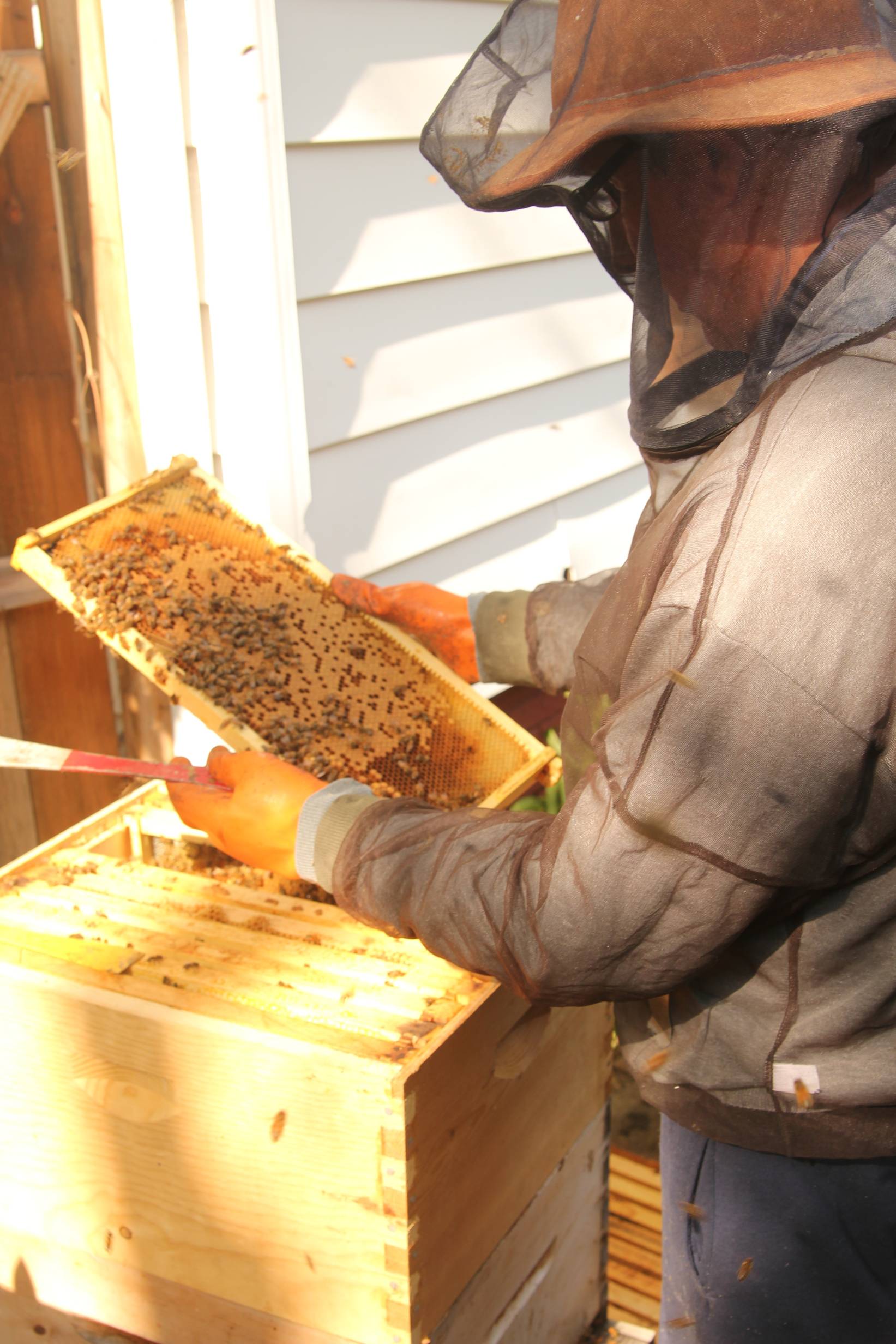 things.” Along with her classes at Parkland and Common Ground, she’s happy to share her passion to anyone interested.
things.” Along with her classes at Parkland and Common Ground, she’s happy to share her passion to anyone interested.
At her teaching apiary in Urbana, she showed off a hive that had sustained heavy losses over the past winter. She’d combined it with a beehive box from a stronger hive by separating the two with a layer of old newspaper, giving each enough time to adjust to the new hive’s scent. Pulling out a lively frame, she smiled under a checkered veil and exclaimed, “Boy this queen is laying!” She didn’t even have to see the queen; she could tell by their packed and brimming wall-to-wall brood laying pattern that the healthy hive’s queen has paid a visit to the weak hive’s frames.
Swiftly squeezing a tin smoker with yellow bellow at the top rim to clear a few stray bees, she begged them, “Go in, you,” while trying to close the cap. She mentioned that pretty soon, she’ll have to add another box:
Getting back to the bees is, in a way, returning to some very deep instincts. . . . You have the satisfaction of knowing that you actually help them, and sometimes they actually work with you, they don’t resist, they don’t sting. They let you go about your business and everyone in the hive has a role, and your role is beekeeper.
All photos by Chris D. Davies.








